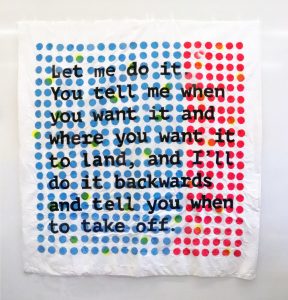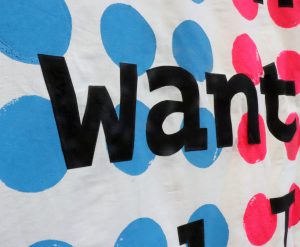Encoded Cloth – Julia and Margot




Intention:
When approaching this project, we knew that we wanted to explore a subject that we were both passionate and interested about, rather than delving into our separate, personal identities. We also knew that we wanted to create some sort of a wall hanging or a quilt, as it would allot us a large amount of space to create on, and neither of us were very familiar with creating clothing or more three dimensional forms.
We eventually decided to focus on the under-representation of women in computer science through the form of a quilt. We chose the medium of a quilt, as we wanted to question the traditional “home-maker role” for women, while creating something that could be very visible in a house or room and celebrate the ground-breaking work of a few women in CS. We were particularly interested in bringing together mediums or components that may not normally be connected to each other, like fabric and technology, and text and textiles.
The main focus of our quilt is a quote by Katherine Johnson, a NASA research mathematician whose calculations were crucial in the U.S’s first trips to space. Inside her quote, we embroidered the names of thirty other prominent female computer scientists. Because we’re both communication designers, we wanted to incorporate typography in the form of Katherine Johnson’s quote, and data visualization in the background, with the colorful dots. The pink dots represent the 29% of women in computer science, and the blue dots represent the men. Of the leadership positions in computer science, only 17% are held by women, as represented by the yellow dots. We based our color scheme off of CMYK, to connect the quilt further to technology and printed material.
Process:
When beginning with this project, we first found the quote we wanted to use, and then created a list of some women in CS. Once we did some initial planning and sketches, we started with the quote portion of the quilt. We knew what dimensions for the quilt we wanted, so in Illustrator, we created an artboard the size of our quilt, and typed out our quote, so that we knew exactly what we wanted it to look like finished. We then printed out and tiled the quote at scale, so that we could reference it later on.
Letters:
For the letters, we decided on iron-on applique, in order to make it easier to cut out and adhere the entire quote onto the quilt. Rather than dyeing our fabric black, we chose to paint it using water and black fabric paint, so that the fabric would have a slightly uneven, not purely black color. In order to transfer the quote onto the black fabric, we projected our illustrator file onto the wall, and used chalk to trace the outlines of each letter. We then split up the list of names, and each took some words to embroider. We decided to embroider the names before cutting out the letters, as we figured once cut, it would be very difficult to do embroidery or to fit the letters into a hoop. While we initially thought we would put one name in every single letter, we decided to instead have one embroidered letter per word, as the embroidery was taking a long time to do. Once the embroidery was done, we ironed on adhesive to the back, and cut out the letters.
Main fabric and block-printing:
In order to get the background fabric of our quilt to be the right dimensions, we sewed two pieces of white cotton together. When designing the data-visualization part of the quilt, we weren’t quite sure how we wanted to make the dots, or what the exact placement of the dots was going to be. We ended up using the round sponges, in order to give the dots a more playful, hand-made feel, as each was then slightly different and unique. After block-printing, Margot trimmed the printed piece of fabric, created the quilt backing by sewing together two pieces of muslin, and set up the quilt batting. She then sewed together the front and the back of the quilt, leaving a gap so that she could turn it back right side out and fill it later on.
Putting everything together:
Using the printed out quote that we had previously tiled, Julia marked out where the letters had to go on the quilt, and ironed on the quote. Margot then put the batting inside the quilt, we stitched up the gap, and started to top-stitch to keep everything together. For top stitching, Margot embroidered little crosses in the middle of some of the dots, so that little “sprouts” could be visible on the backside of the quilt. In addition to the embroidery, we used the sewing machine to stitch near the left and right edges of the quilt. However, the sewn lines ended up puckering and pulling the fabric, so that it didn’t look as clean.
Learning:
This was a really interesting project because it allowed us to not only explore a medium that we may not have done on our own, but also it allowed us to pursue a larger project. Because there were two of us, we were able to put together an entire quilt in a fairly short amount of time. Thus, we were able to learn each step of the quilt making process, as well as try out other techniques like block printing. It was interesting hearing what everyone else had to hear during our critique. We were really surprised that so many people were able to contextualize the quilt, and figure out what both the quote and the data visualization could represent. If we were to continue, I think we could make those meanings slightly clearer or apparent, as well as to make the embroidery slightly easier to read, as people weren’t able to make out the cursive. In the future, I think we would both love to continue making quilts and to apply what we’ve learned through this process to our future projects.